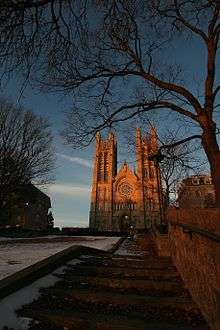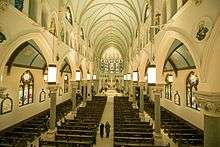Basilica of Our Lady Immaculate
| Basilica of Our Lady | |
|---|---|
| Basilica of Our Lady Immaculate, Guelph | |
 Southwest view of the basilica | |
| Coordinates: 43°32′35.3″N 80°15′4.2″W / 43.543139°N 80.251167°W | |
| Location | Guelph, Ontario |
| Country | Canada |
| Denomination | Roman Catholic |
| Website | ChurchofOurLady.com |
| History | |
| Dedication | 1883 |
| Architecture | |
| Status | Active |
| Functional status | Minor basilica |
| Heritage designation | National Historic Site of Canada |
| Designated | 1990 |
| Architect(s) | Joseph Connolly |
| Architectural type | Norman-Gothic |
| Administration | |
| Deanery | Wellington[1] |
| Diocese | Hamilton |
| Province | Toronto |
Basilica of Our Lady Immaculate is a Roman Catholic minor basilica and parish church located in Guelph, Ontario, Canada. A Gothic Revival style building designed by Joseph Connolly. It is considered Connolly's best work.[2] To serve a Roman Catholic parish of predominantly German settlers the church was built between 1875 and 1883. The monumental church contains decorative carving and stained glass executed by skilled craftsmen.[3]
The church was designated a National Historic Site of Canada in 1990.[2][4] Pope Francis designated the church a basilica on 8 December 2014.[5][6]
History
When John Galt founded Guelph, Ontario on April 23, 1827, he allocated the highest point in the centre of the newly founded town to Roman Catholics as a compliment to his friend, Bishop Alexander Macdonell, who had given him advice in the formation of the Canada Company. A road was also later cleared leading up to the hill and named after the Bishop, called Macdonell Street.
According to the Guelph Public Library archives, Galt wrote the following statement in the deed transferring the land on which the Church of Our Lady would one day stand: "On this hill would one day rise a church to rival St. Peter's in Rome."

The Roman Catholic Church of Our Lady Immaculate is the third church to stand on this site, high above the streetscape, overlooking the city of Guelph. The first church, a framed wooden church named St. Patrick's, had been built on the hill by 1835 and was the first structure in Guelph that was painted on both its interior and exterior. It burned to the ground on October 10, 1844.
Construction on St. Bartholomew's Church began shortly after St. Patrick's was destroyed. The new building was completed in 1846. The following inscription appeared on the cornerstone of St. Bartholomew's Church: "To God, the best and greatest. The faithful of Guelph, of the diocese of Toronto have built this new Church, in honour of the blessed Apostle Bartholomew, the first church having been consumed in flames."
Construction of the new church, based on the Cologne Cathedral,[5] began in 1877 under Irish-Canadian architect Joseph Connolly who had designed many churches in Ireland, England and Ontario, notably St. Peter's Cathedral in London, Ontario.
Built of local limestone in Gothic Revival style, the Church of Our Lady is considered to be Connolly's masterpiece. Matthew Bell, a well-known Guelph artisan, was responsible for some of the carvings on the exterior as well as on the interior pillars of the church. He died in 1883 as a result of injuries sustained in a fall while working on the building. In 1888, almost twelve years after construction commenced, the church was dedicated to Our Lady Immaculate. The twin towers, which rise to a height of over 200 feet (61 m), were not completed until November 13, 1926. The completed church stands at the head of MacDonell Street as an imposing view terminus, similarly to another major project by Connolly, St. Mary's Church in Toronto.
In 1958 a new entrance from Macdonell Street was constructed, but aside from this, the exterior appearance of the Church has changed very little since 1926.
The complete building of the church took more than 50 years, probably qualifying it as the longest construction project in the city's history.

Present day
The church of Our Lady is one of the 122 parishes in the Diocese of Hamilton and boasts 2,600 families in the congregation.

Long-awaited restoration of the church began in April 2007 and was completed in December 2014, costing over $12 million.[7] Talk of restoration began in the early 1990s, with work on the slate roof completed in 1992. Subsequent plans for renovating the interior generated some controversy and were put on hold. Initially, the estimated cost of the inside and outside restoration was between $10 million and $12 million and was expected to last until 2008. It included renovations to the towers ($1.2 million), roof, windows and doors, interior and basement. Funding came from both the congregation and the diocese of Hamilton.[8]
City by-laws
The City of Guelph's zoning by-laws establish "protected view areas" that are designed to ensure clear sight lines to the Church of Our Lady from various vantage points in the downtown core. Any communication towers or other buildings built in the downtown area must not obscure the view of the church. Also, no new buildings in Guelph are allowed to be higher in elevation than the Church.[9]
Gallery
 Basilica of our Lady Immaculate in winter
Basilica of our Lady Immaculate in winter October view, near rivers confluence
October view, near rivers confluence October view, different sky
October view, different sky October view from lattice covered footbridge
October view from lattice covered footbridge- Sunset view from the Farmer's Market
 Main entrance
Main entrance Inside the basilica - Pre-Restoration
Inside the basilica - Pre-Restoration- Inside the basilica - Post-Restoration
- Commemorative Plaque of Cardinal Collins visit to his home church, (then) Church Of Our Lady In Guelph
Notes and references
- ↑ Parish info from Holy Rosary Church, Guelph retrieved 5 July 2014
- 1 2 Our Lady of the Immaculate Conception. Canadian Register of Historic Places.
- ↑ Church of the Immaculate Conception from Ontario Heritage Trust, retrieved 12 December 2014
- ↑ Our Lady of the Immaculate Conception, Directory of Designations of National Historic Significance of Canada
- 1 2 Basilica has nice ring to it from Guelph Tribune, 11 December 2014, retrieved 12 December 2014
- ↑ Iconic city church elevated to basilica from Guelph Tribune, 11 December 2014, retrieved 12 December 2014
- ↑ Guelph's Church of Our Lady now a Basilica, 14 December 2014, Guelph Mercury, retrieved 15 December 2014
- ↑ "Catholic Register". Catholic Register. Archived from the original on 2007-06-24. Retrieved 2007-07-09.
- ↑ "Policy: Communication Towers and/or Antennas" (PDF). City of Guelph. Archived from the original (PDF) on 2007-09-27. Retrieved 2007-07-09.
External links
| Wikimedia Commons has media related to Basilica of Our Lady Immaculate, Guelph. |